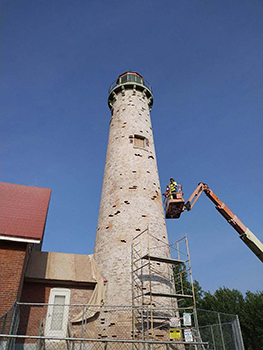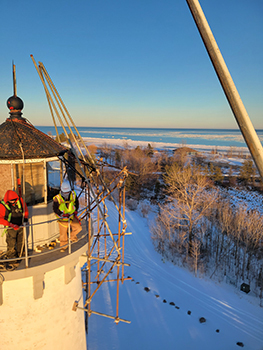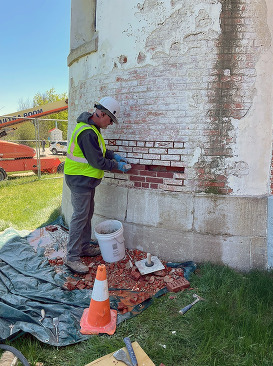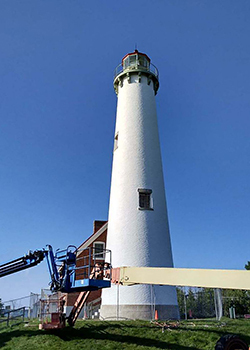Restoring the Tawas Point Lighthouse
By ROBBERT MCKAY, Parks and Recreation Division and LAURIE CATHERINE PERKINS, Michigan History Center,
Michigan Department of Natural Resources
Located in an area often referred to as the “Cape Cod of the Midwest,” Tawas Point Lighthouse at Tawas Point State Park in Iosco County is a fixture of the scenic Lake Huron shoreline.
Before Tawas Point State Park became a destination for thousands of tourists each summer, East Tawas was a 19th-century lumber and fishing town at the mouth of the Tawas River. Known to local bands of the Anishinaabek, hundreds of years before the arrival of Europeans, this same area was used for hunting and fishing by native peoples.
For the past several hundred years, wind and waves from Lake Huron have created a spit of sand at the mouth of Tawas Bay, an obstacle hard to see at night or in bad weather.
As the 19th-century population of East Tawas grew, so did the natural resource-based economy around it. With hundreds of thousands of dollars of lumber sitting on local docks, the community’s maritime and lumber interests began petitioning the federal government for a lighthouse at the end of Ottawa (later Tawas) Point.

The community effort proved successful, and in 1853, the federal government built a lighthouse, at a cost of $5,000. The new lighthouse was powered by whale and lard oil lamps.
In less than a quarter century, wind and wave action would again move nearly a mile of sand, creating the need for a new lighthouse. A government expenditure of $30,000 allowed for the completion of a new lighthouse, which opened for the first day of navigation on May 2, 1877.
Now powered by a single kerosene lamp, the fifth-order Fresnel lens shot a beam of light through the darkness that could be seen for 16 miles. The new lighthouse and its keeper’s dwelling were located at the very tip of the newly formed point of land.
This new beacon was so close to the water that the keeper could land a boat almost at his doorstep. Later, on the evening of Sept. 1, 1891, light from a new and larger fourth-order Fresnel lens pierced the night sky.
Tawas Point Lighthouse was converted to electrical power in 1935. With the light fully automated in 1953, the last lightkeeper from the U.S. Lighthouse Service left the lighthouse. The U.S. Coast Guard took up residence in his place.
|

By 1991, the Coast Guard had stopped lodging keepers at the lighthouse but continued to maintain the light and own the structures and property.
The Michigan Department of Natural Resources took over the Tawas Point Lighthouse and property from the federal government and began rehabilitation work and interpretive programing in 2001, creating public spaces that would share the history of the lighthouse with its thousands of annual visitors.
Lighthouse restoration
With federal funding allocated to states over the past couple of years, Tawas Point State Park and Lighthouse received a $455,000 grant through the American Rescue Plan Act for restoration of the lighthouse tower.
Guided by construction documents prepared by historical architects at WTA Architects in Saginaw, construction work began in the spring of 2023. Mihm Enterprises, Inc., a full-service contracting company located in Hamilton, Michigan, was selected to complete the work. The company is highly regarded in commercial and residential historical restoration.
|

Collectively, WTA Architects and Mihm Enterprises, Inc. have received five Governor’s Awards for Historic Preservation and five Michigan Historic Preservation Network Building Awards.
Bob Ziman, project manager at Mihm Enterprises, Inc., said the Tawas Point Lighthouse is the company’s 23rd Michigan lighthouse restoration project.
The focus of the Tawas restoration has been to identify and correct moisture and ventilation issues that have accelerated the deterioration of the lantern room, gallery and brick tower shaft.
Surprising to many repeat visitors are the new lantern and gallery colors. The colors, based on a paint color analysis of the tower conducted previously, reflect the colors present at the lighthouse circa 1895.
The tower itself remains white, its traditional daylight navigational color. While a modern, high-performance paint system was used on the lantern room and gallery, a lime-based paint was used on the tower.
|

In combination, these changes will help reduce tower deterioration and present an historically accurate appearance to visitors.
Judging from the public reaction on the Friends of Tawas Point Lighthouse and State Park Facebook page, lighthouse enthusiasts from Michigan and around the world can’t wait to tour the newly restored lighthouse and get a closer look at Mihm Enterprises, Inc.’s work.
“Simply beautiful,” Chris Zimmel, secretary of the Friends of Tawas Point Lighthouse and State Park, said of the results.
Lighthouse keeper program
In 2008, the Michigan History Center created a resident Lighthouse Keeper Program that remains popular to this day. The program is designed so that members of the public can experience what it was like to be a lighthouse keeper at Tawas Point Lighthouse.
Hundreds of potential keepers apply to the program each year from all over the United States and around the world. The program is highly competitive.
|

With the restoration of the lighthouse complete, the program, on hold for several years, will resume operation in late spring of 2024. Those chosen to be keepers will stay in the upper floor of the 1877 keeper’s dwelling. The space includes two bedrooms that sleep up to four individuals, a kitchen and a full bath.
For details about the Lighthouse Keeper Program at Tawas Point Lighthouse, email DNR-TawasKeepers@Michigan.gov.
The Friends of Tawas Point Lighthouse and State Park invite you to become a member at TawasLighthouseFriends. Follow the site’s many events and activities at Michigan.gov/TawasLighthouse.
|
Check out previous Showcasing the DNR stories in our archive at Michigan.gov/DNRStories. To subscribe to upcoming Showcasing articles, sign up for free email delivery at Michigan.gov/DNREmail.
Note to editors: Contact: John Pepin, Showcasing the DNR series editor, 906-226-1352. Accompanying photos and a text-only version of this story are available below for download. Caption information follows. Credit Michigan Department of Natural Resources, unless otherwise noted.
Text-only version of this story.
After: Once the brick exterior was patched, a historic whitewash was applied from top to bottom. The lighthouse is now better preserved and more historically accurate. Credit: Mihm Enterprises, Inc.
Before: Previous restoration had covered the brick tower in a cement coating called parge. By 2020, the parge had failed along the tower, damaging original brick. Credit: Ana Eastlick, 2020 Michigan State Parks photo ambassador.
Historic: When Tawas Point Lighthouse was completed in 1876, the lighthouse keeper could dock a boat almost at his front door.
Masonry: Once the parge coating was removed, masons replaced damaged brick and mortar. Credit: Mihm Enterprises, Inc.
Scaffolding: Work began in early 2023, before the snow had melted. Here, workers install scaffolding around the top of the tower in March. Credit: Mihm Enterprises, Inc.
Testing: In late May, masons tested their technique for removing the parge coating without damaging the underlying brick. They also removed and replaced a few damaged bricks in the sample area using the specified brick and mortar. Credit: Mihm Enterprises, Inc.
Ventilation: Improper ventilation contributed to the damage to the lighthouse tower. To fix the issue, Mihm replaced two of the tower’s windows with ventilation louvers that allow air to flow freely within the tower all year long. Credit: Mihm Enterprises, Inc.
|